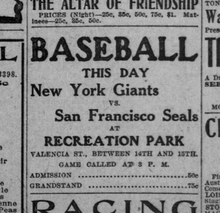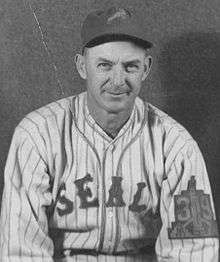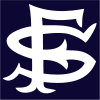San Francisco Seals (baseball)
|
San Francisco Seals 1903–1957 San Francisco, California | |||||
| |||||
| Class-level | |||||
|---|---|---|---|---|---|
| Previous |
| ||||
| Minor league affiliations | |||||
| League | Pacific Coast League (1903–1957) | ||||
| Major league affiliations | |||||
| Previous |
| ||||
| Minor league titles | |||||
| League titles | 1909, 1915, 1917, 1922, 1923, 1925, 1928, 1931, 1935, 1943, 1944, 1945, 1946, 1957 | ||||
| Team data | |||||
Previous names | San Francisco Seals (1903–1957) | ||||
Previous parks |
| ||||
The San Francisco Seals were a minor league baseball team in San Francisco, California, that played in the Pacific Coast League from 1903 until 1957 before transferring to Phoenix, Arizona. They were named for the abundant California sea lion and harbor seal populations in the Bay Area. The 1909, 1922, 1925, and 1928 Seals were recognized as being among the 100 greatest minor league teams of all time.[1]
Early history
Along with the Los Angeles Angels, Portland Beavers, Oakland Oaks, Sacramento Solons, and Seattle Indians, the Seals were charter members of the Pacific Coast League, which was founded in 1903. The team played their home games at Recreation Park at Harrison and 8th Streets until it was destroyed in the 1906 earthquake.
The mild climate of the west coast allowed the PCL to play a much longer season than the major leagues and the other eastern professional baseball leagues. Seasons often ran 200 games or more, especially in the early years. In the 1905 season, the Seals set the all-time PCL record by playing 230 games (Pacific Coast Baseball League Record Book 1903–1969, compiled by William J. Weiss, League Statistician; published by the PCL, 1969; p. 30).

The Seals finished the 1906 season playing home games at Freeman's Park in Oakland. A new Recreation Park was constructed at 14th and Valencia Streets for the 1907 season. The Seals won their first PCL pennant in 1909, finishing 13 1⁄2 games over the runner-up Portland Beavers. They won flags also in 1915, 1917, 1922, 1923 and 1925.
During the 1914 season, the Sacramento Solons were moved to San Francisco, where they finished out the season playing as the San Francisco Missions, representing the city's Mission District. The idea of a second team in San Francisco remained alive and, after the 1925 season, the Vernon Tigers were purchased by a group headed by San Francisco businessman Herbert Fleishhacker and moved to San Francisco and renamed the Mission Reds or simply the "Missions", again representing the Mission District as this team played their games five blocks from Mission San Francisco de Asís. From 1926 through 1930, they played their home games at Recreation Park, playing at home while the Seals were on the road.
In 1918, financially strapped owner Henry Berry put the San Francisco Seals up for sale and Charles H. Strub, George Alfred (Alfie) Putnam and Charles H. Graham each acquired a one-third share in the team.
In 1931, the Seals moved to their own park, Seals Stadium, an 18,600-seat facility located at 16th and Bryant Streets. Seals Stadium was unusual in that it boasted three clubhouses: one for the visitors, one for the Seals, and one for the Missions, who moved there with the Seals and were the Seals' tenants from 1931 through 1937, after which the team moved back to Los Angeles to become the Hollywood Stars in 1938.
There were three breweries on the adjoining northwest corners of Seals Stadium, which included Hamm's, Budweiser and Lucky Lager.
The Seals celebrated their inaugural year in Seals Stadium by winning the PCL pennant in 1931. The following year, Seals outfielder Vince DiMaggio arranged a tryout for his younger brother Joe. In 1933, Joe DiMaggio hit safely in 61 straight games,[2] a harbinger of his 56-game hitting streak for the New York Yankees in 1941. The team won the pennant again in 1935.
Change of control

In 1945, a controlling interest in the team was purchased by businessman Paul Fagan, with the stated intention of bringing Major League Baseball to the west coast by having the Pacific Coast League becoming the nation's third major league. He spent thousands of dollars upgrading Seals Stadium to perceived major league standards. He hired former major league player Lefty O'Doul, a native San Franciscan and fan favorite, as manager. Though the Seals won the pennant in 1946, subsequent teams under Fagan's watch did not fare as well, typically finishing in the second division. Rival clubs did not buy into Fagan's major league ambitions. Rather, they established working agreements with major league teams, and fared better than did the independent Seals.
Fagan gave up his aspirations and sold his interest in the Seals, who became an affiliate of the Boston Red Sox. After their Bay Area rival, the Oakland Oaks, moved to Vancouver after the 1955 season, the Seals won their last PCL pennant in 1957, which proved to be their final season. Late in that season, the New York Giants announced their move to San Francisco for the 1958 season, and the Seals were forced to relocate.
The Seals moved to Phoenix, Arizona for the 1958 season. They became the top affiliate of the now-San Francisco Giants, and were renamed the Phoenix Giants. The franchise then moved to Tacoma, Washington, where they played from 1960 to 1965, returning to Phoenix for the 1966 season. The team remained in Phoenix–from 1986 onward as the Firebirds–until 1998, when they were displaced by MLB's Arizona Diamondbacks. In a complicated deal, the Firebirds' ownership group bought the Tucson Toros, inheriting the Toros' staff and facilities. After an interim one-year affiliation with the Milwaukee Brewers, the Toros affiliated with the Diamondbacks and changed their name to the Sidewinders. The Giants' affiliation was transferred to the displaced Tucson AAA franchise, which became today's Fresno Grizzlies. In 2009, the Sidewinders franchise moved to Reno, Nevada. They retained their affiliation with the Arizona Diamondbacks as the Reno Aces, and play their home games at Aces Ballpark. The Tucson Toros returned under the same ownership as the Sidewinders, but they are not affiliated with a major league club. The new Toros played their home games at Hi Corbett Field, the longtime home of minor league baseball in Tucson, until 2010.
The Giants played their home games at Seals Stadium in 1958 and 1959, moving to Candlestick Park in 1960. Seals Stadium was subsequently torn down to make way for a White Front store. When this chain of stores went out of business, the building stayed empty for some years. It was finally turned into a car dealership and later a Safeway grocery store. The legacy of the Seals lives on in the Giants' mascot Lou Seal, as well as in a statue of the Seals' cartoon mascot (c. 1947) at AT&T Park, and with a marker on the 16th & Bryant sidewalk placed where Seals Stadium home plate stood.
Rebirth in 1985
The Seals were reborn as a collegiate woodbat team in 1985 by Bay Area high school coach Abel Alcantar. He put together teams at various levels from U13 to the collegiate level. The collegiate team now plays in the Great West League as of 2018.
Affiliations
The Seals were largely independent of major league farm systems except for the following affiliations:
| Year | Affiliation(s) |
|---|---|
| 1936; 1945 | New York Giants |
| 1942 | Brooklyn Dodgers |
| 1951 | New York Yankees |
| 1956–57 | Boston Red Sox |
Notable alumni
- Earl Averill, Major League Baseball outfielder, Hall of Fame
- Frank Bodie, Major League Baseball outfielder
- Sam Bohne (originally "Sam Cohen"; 1896-1977), Major League Baseball infielder
- Syd Cohen, Major League Baseball pitcher
- Frank Crosetti, Major League Baseball infielder
- Dominic DiMaggio, Major League Baseball outfielder
- Joe DiMaggio, Major League Baseball outfielder, Hall of Fame
- Vince DiMaggio, Major League Baseball outfielder
- Babe Ellison, MLB player and member of Pacific Coast League Hall of Fame
- Ferris Fain, Major League Baseball Infielder, 2-time American League batting champion
- Harry Feldman, Major League Baseball pitcher
- Vernon "Lefty" Gomez, Major League Baseball pitcher, Hall of Fame
- Smead Jolley, Major League Baseball outfielder
- Jack Mealey (born 1899), catcher, manager in minor leagues and president of Sooner State League
- Lefty O'Doul, Major League Baseball outfielder; Seals manager, Japanese Baseball Hall of Fame, Bay Area Sports Hall of Fame
- Albie Pearson, Major League Baseball outfielder, 1958 AL Rookie of the Year, 1963 All-Star
- Babe Pinelli, Major League Baseball infielder and umpire
- Gus Suhr, Major League Baseball outfielder
- Paul Waner, Major League Baseball outfielder, Hall of Fame
- George "Buck" Weaver, Major League Baseball infielder, Member of the 1919 Chicago "Black Sox"
- Gene Woodling, Major League Baseball outfielder
References
Notes
- ↑ "Top 100 Teams". MiLB.com. 2001. Retrieved May 9, 2017.
- ↑ Great Baseball Feats, Facts and Figures, 2008 Edition, p. 210, David Nemec and Scott Flatow, A Signet Book, Penguin Group, New York, ISBN 978-0-451-22363-0
Sources
- Kelley, Brent P.. The San Francisco Seals, 1946–1957. McFarland & Company, Inc., Jefferson, North Carolina, 1995. ISBN 0-7864-1188-0.
- O'Neal, Bill. The Pacific Coast League 1903–1988. Eakin Press, Austin TX, 1990. ISBN 0-89015-776-6.
- Snelling, Dennis. The Pacific Coast League: A Statistical History, 1903–1957 McFarland & Company, Inc., Jefferson, North Carolina, 1995. ISBN 0-7864-0045-5.
External links
| Wikimedia Commons has media related to San Francisco Seals. |
- Minor League Baseball's "Top 100 Teams" entry on the 1925 San Francisco Seals (team #10)
- Minor League Baseball's "Top 100 Teams" entry on the 1922 San Francisco Seals (team #44)
- Minor League Baseball's "Top 100 Teams" entry on the 1928 San Francisco Seals (team #50)
- Minor League Baseball's "Top 100 Teams" entry on the 1909 San Francisco Seals (team #71)
| Preceded by Louisville Colonels |
Boston Red Sox AAA affiliate 1956–1957 |
Succeeded by Minneapolis Millers |
